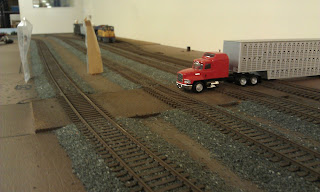Another impulse buy from eBay. I spotted this collection of detail parts going for a song so I snapped them up. There are about forty packets of parts, including several complete sets of Smokey Valley handrails.
Several of the parts are for SD50/60 locomotives, inluding a set of brass handrails, which will be perfect for my old school blue-box SD60 kitbash.
I also picked up a couple of Athearn GP60 Shells to use for the build, one of which turned out to be an in-progress Santa Fe unit which has already had a considerable amount of detailing time put into it.
The SD60 build will require only parts of a shell and it would be a shame to undo all that great work. I expect this locomotive will get finished off and painted instead of being hacked up, although I don't have any SF decals at the moment...
At this rate I will need to get a second organiser to keep my parts in, I've got a surprising amount of bits-n-pieces I've accumulated over the past couple of years, with all manner of small details west and Cannon parts in the box. Even with all those packets I still never seem to have the actual part I need at any time though!












